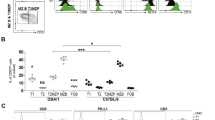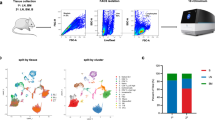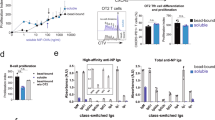Abstract
Splenic lymphocytes of C3H/HeJ mice are defective in responding to the mitogenic activity of bacterial lipopolysaccharide (LPS)1–4, which has been attributed to a mutation at a single gene locus on chromosome 4 (ref. 5). It was suggested that C3H/HeJ mice lack a cell-surface receptor necessary for LPS recognition6,7. However, specific binding of 125I-labelled lipid-A of LPS to B cells was found to be equivalent in LPS-responder and LPS-nonresponder C3H/HeJ, C57BL/10 ScCR and C57BL/10 ScN mice8. This suggests that the genetic defect in C3H/HeJ mice is related to triggering mechanisms rather than to LPS binding. We recently established a method for separating mouse splenic lymphocytes into karyoplasts (minicells) and cytoplasts (enucleated cells) with high purity9. This method makes possible the exchange of nuclei from one type of lymphocyte to another. In the present study, karyoplasts were purified from LPS-nonresponder C3H/HeJ mice and transferred to mitomycin C-treated or X ray-irradiated splenic lymphocytes taken from LPS-responder C3H/HeN mice by fusion with polyethyleneglycol. These reconstituted hybrid cells could respond to LPS, suggesting that nuclei from C3H/HeJ mice could be activated by LPS if proper signals were provided from cell-surface receptors. Moreover, responsiveness to concanavalin A (Con A) of mitomycin C-treated or X ray-irradiated lymphocytes was also recovered by the microinjection of karyoplasts from untreated lymphocytes.
This is a preview of subscription content, access via your institution
Access options
Subscribe to this journal
Receive 51 print issues and online access
$199.00 per year
only $3.90 per issue
Buy this article
- Purchase on Springer Link
- Instant access to full article PDF
Prices may be subject to local taxes which are calculated during checkout
Similar content being viewed by others
References
Sulzer, B. M. Infect. Immun. 5, 107–113 (1972).
Watson, J. & Riblet, R. J. exp. Med. 140, 1147–1161 (1974).
Coutinho, A., Moller, G. & Gronowicz, E. J. exp. Med. 142, 253–260 (1975).
Glode, L. M., Sher, I., Osborne, B. & Rosenstreich, D. L. J. Immun. 116, 454–461 (1976).
Watson, J., Riblet, R. & Taylor, B. A. J. Immun. 118, 2088–2093 (1977).
Forni, L. & Coutinho, A. Eur. J. Immun. 8, 56–62 (1978).
Coutinho, A., Forni, L. & Watanabe, T. Eur. J. Immun. 8, 63–67 (1978).
Gregry, S. H., Zimmerman, D. H. & Kern, M. J. Immun. 125, 102–107 (1980).
Ohara, J., Sekiguchi, T. & Watanabe, T. (in preparation).
Wigler, M. H. & Weinstein, I. B. Biochem. biophys. Res. Commun. 63, 669–674 (1975).
Watson, J., Kelly, K., Largen, M. & Taylor, B. A. J. Immun. 120, 422–424 (1978).
Carter, S. B. Nature 213, 261–264 (1967).
Pontecorrvo, G. Somat. Cell Genet. 1, 394–400 (1975).
Kohler, G. & Milstein, C. Nature 256, 495–497 (1975).
Melchers, F., Potter, M. & Warner, N. L. (eds) Curr. Topics Microbiol. Immun. 81 (1978).
Kennett, R. H., Mckearn, T. J. & Bechtol, K. B. (eds) Monoclonal Antibodies (Plenum, New York, 1980).
Author information
Authors and Affiliations
Rights and permissions
About this article
Cite this article
Watanabe, T., Ohara, J. Functional nuclei of LPS-nonresponder C3H/HeJ mice after transfer into LPS-responder C3H/HeN cells by cell fusion. Nature 290, 58–59 (1981). https://doi.org/10.1038/290058a0
Received:
Accepted:
Published:
Issue Date:
DOI: https://doi.org/10.1038/290058a0
This article is cited by
Comments
By submitting a comment you agree to abide by our Terms and Community Guidelines. If you find something abusive or that does not comply with our terms or guidelines please flag it as inappropriate.



